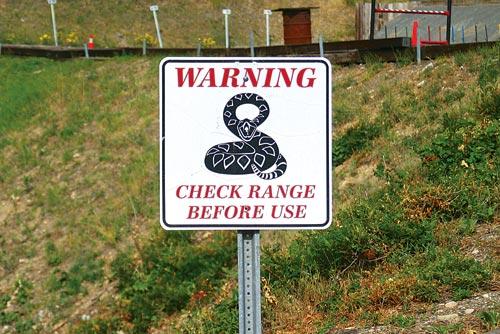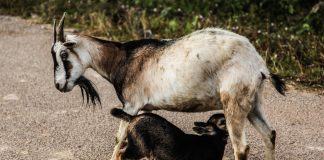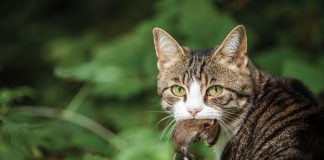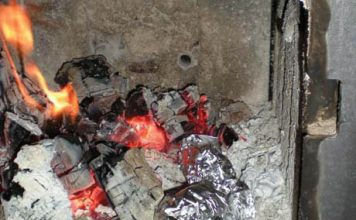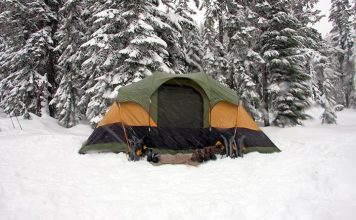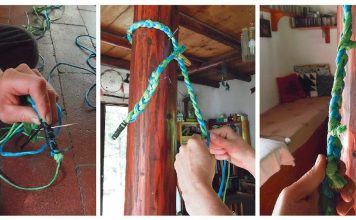| By Massad Ayoob |  |
| Issue #151 • January/February, 2015 |

Mas safely kills a rattlesnake in a populated area. (Note angle of gun and trajectory.) Pistol is a Springfield EMP loaded with 9mm 127 grain +P+ Winchester Ranger-T ammunition. No, there was no time to put on earmuffs.
Snakes are part of Nature, and Nature is what the backwoods home lifestyle is all about. We have subscribers who keep snakes for pets, and many more who appreciate snakes keeping down the rodent population. And, you know, I get that. We in the gun community aren’t all about “if we can shoot something, shoot it!” the way the anti-gunners falsely say we are. There was no greater gun guru in my lifetime than Col. Jeff Cooper, who, when he established his famous American Pistol Institute at Gunsite Ranch in Arizona immediately established the rule that the rattlesnakes were there first, and were not to be shot, but to be assiduously avoided.
However, I’m also friends with the first guy who broke the late Colonel’s rule. It rattled, it was close, and my friend reflexively blew it away with his Glock. I understand that too.
Just as there are good people and bad people, there are good snakes and bad snakes. Historically, we humans figured out early that the good snakes devour the rats that eat food meant for our species, and are our friends, and the bad snakes are the ones that have the potential to kill us, and our cubs, and our livestock. Poisonous snakes can kill adult humans, though it’s relatively rare that they do in this country, but their bite is much more likely to be fatal to a child, or to the animals we keep as pets and livestock.
Given that I’m the firearms editor of this publication, not the resident herpetologist, you can probably figure out where I stand on that. Non-poisonous snakes are welcome on my own rural property. The venomous kind are not. We all need to know what legally protected species are illegal to shoot. That said, though, we also need to recognize the legal principle called the Doctrine of Competing Harms, also known as The Doctrine of Two Evils and the Doctrine of Necessity. This blessed proof of the wisdom of the law says that you’re allowed to break the law in the rare circumstance where following the law would cause more human injury than breaking it. This is why, even though murder of a human being is one of the most rigidly punished crimes in the history of civilization, there has always been such a thing as justifiable homicide in self-defense, or in defense of another person one has the right to protect. It turns out that this works for scaly reptiles as well as it does for the deadly “snakes” who walk on two legs.
So, as unpleasant and politically incorrect as the topic may be, let’s talk about shooting poisonous snakes.

A rattlesnake in Arizona slithers under a car door.
The scope of the problem
If you don’t live where snakes can kill you, no problem. But you might find yourself traveling to where that’s no longer the case. I spent most of my life as a resident of New Hampshire where, except for one small and unique pocket in the southern part of the state, you just don’t find poisonous reptiles. I didn’t get to visit Arizona until the mid-1970s, but instantly fell in love with that wonderful state. From the beginning, lifelong residents warned me about rattlers here and sidewinders there, and for years when I wandered through the desert, my eyes were constantly darting about in search of serpents. I never saw one. Now, this may be that I simply didn’t have the right eyes for it, and the snakes saw me as harmless and benevolently restrained themselves from sinking their fangs into me and injecting me with lethal venom. But I finally came to see it as, “Aw, hell, these Arid Zoners are just making fun of the Yankees again.”
Until the day came when I had to shoot a rattlesnake in a dirt parking lot inside the city limits of Phoenix.
Yes, I was damn glad I was carrying a Springfield Armory EMP pistol, and equally glad that the 127 grain +P+ Winchester 9mm jacketed hollow point is as destructive a load as it is. The rattler had first been spotted under an open-front outside staircase which children regularly traversed, and just before I killed it, it was under the driver’s door of a parked car, ideally positioned to bite whoever opened the door. Sorry, PETA, but no regrets here.
A year or so later, a rattler turned up in Indiana when my girlfriend and I were on a rural range, teaching her young grandson how to shoot a pistol. The gun on my hip at that time was a Glock 17, loaded with round-nose 115 grain full metal jacket practice ammo. The snake was coming toward us when I shot for its head. The bullet cut its jaw loose, dropping it into a gaping “I can’t believe you just shot me!” position, and it was still coming toward us when the second shot took it in the brain and ended the matter.
There are poisonous snakes who want to bite you, and some that don’t, and some with whom you just can’t take the chance. When I bought a home in Florida a decade ago, I discovered that the resident water moccasins, also known as cottonmouths, will aggressively attack humans. One night, I was escorting a couple of visiting friends from my house to their car. Trotting alongside us was a sweet little rescue dog, a Catahoula Cur bitch I temporarily named LadySmith the Range Dog while she was staying with me, and she alerted to something moving in the grass toward us. It was a medium-size water moccasin. I drew my Glock 31 from its holster on my hip and, mindful of the ear-splitting report of its .357 SIG cartridge, put my left hand over my left ear and dropped my right ear down to my right shoulder as I fired one-handed.
And missed.
The damn thing came right at me, slithering laterally, which “complicated the marksmanship problem.” Four more shots followed. Two took pieces of the snake away from its body, and two more missed. I finally steadied down and carefully squeezed off the sixth shot, and discovered that a 125 grain Speer Gold Dot bullet going 1430 feet per second will vaporize the head of a good-sized snake.
I learned a couple of things from that. I made sure that LadySmith got placed in an extra-special-good home with a couple of little boys who loved her, and I made sure the next time I had to shoot a snake, I took a solid two-hand hold and didn’t worry about hearing loss. (Think about it: when you’re in a kill or die situation, how much are you going to hear in the grave?) Those next times were the Phoenix rattler (no time to don earmuffs, but the well-documented “auditory exclusion” effect that occurs to us when we’re in danger made the shot sound distant and muffled), and Indiana, where I thankfully already had range earmuffs on.
Another factor that can determine whether you have to kill a poisonous snake is the relative accessibility of medical intervention if your humanitarianism fails you and you or someone else takes a venomous bite. I’ve never been in a “cobra country,” but over the course of two safaris I spent about five weeks in the South African bush, and there we were told emphatically that any mamba in general and the black mamba in particular was highly lethal: that far from civilization and high speed transport, a bitten human just couldn’t expect to get to a hospital before death ensued, and antivenin simply wasn’t available in the field. We were told to kill mambas on sight. It wasn’t a suggestion, it was a non-negotiable rule for the safety of all humans involved. I was glad to never see one.
The only time I’ve actually hunted snakes was when a next-door neighbor to my Florida place found his pond overrun with water moccasins. He and his wife are Rottweiller breeders, and the doctrine of competing harms kicked in: the moccasins lost the coin toss. The Mrs. got tired of having to draw the compact 9mm she always had holstered on her hip to shoot snakes off the back porch to keep them from killing the puppies. We hunted them from the water and from the shoreline, and more than three dozen poisonous snakes later, we finally seemed to have cleaned them out.
Upon review, I don’t apologize for that, either.

A warning on a rattlesnake-infested shooting range.
Silent rattlers
I had been hearing about “the new breed of rattlesnakes that don’t rattle to warn you,” and I tossed that out on my blog at backwoodshome.com. That generated some fascinating feedback. “TW” commented, “Maybe the snakes are like the quail. You shoot the quail that fly and don’t see the ones that run. After a while all you have left in the gene pool are the runners. Maybe the snakes that are audible are the first ones dispatched. After a while all you have left in the gene pool are the ones that well, you get my point. In my younger days hunting in the South Texas brush country, there were both kinds. The closest I ever came to was one that didn’t warn me. I was chasing down quail through thick brush and my next step would have been right on him. I could swear I stopped in mid-air and stepped backwards (like in the cartoons) and immediately blew that diamondback into two pieces with a 20 gauge. BTW, shoot a snake with a shotgun at close range and it will become airborne from the rebounding energy. This is something that many hunters have to learn from experience. If you are standing back and watching your partner get this experience, it makes for some interesting and funny visuals. The laughing never stops that evening.”
A great pistol champion I’m proud to call an old friend, Ken Tapp, responded from his current digs in Oklahoma: “The word around this part of OK is rattlers have learned that if they rattle a wild hog will eat them. Snakes must be slow learners as we humans have been killing them for as long as we have been in the same area. Eve had not caught on to how she ought to have responded to her Eden serpent. If you fire a hundred thousand rounds of big bore pistol ammo without ear protection you cannot hear a snake rattle anyway.”
Pete Sheppard added, “When I was in college, one of my courses was ‘herpetology’ (the study of reptiles). My professor told us that there is a genetic strain of rattlers that doesn’t rattle when threatened. If people reflexively kill the rattling rattlers, what’s left? By the way, rattlesnakes are probably more scared of us than we of them. When they buzz, all they are doing is trying to say, in effect, ‘I’m over here, please leave me alone.'”
And “Shotgunner” commented, “30 years studying reptiles here. It’s a form of natural selection. Here is how it works. In a given population, not all rattlesnakes rattle. Some are more calm than others. As you illustrate, in areas frequented by humans, the nervous ones that rattle get killed. The calm/quiet ones live, and pass on their calm genes. Over 20 years the population of Southern Pacific rattlesnakes in one local canyon popular with hikers went from lots of nasty b@stards to almost none that rattle. The local people think they all got killed off. They are still there. When a herper goes in, we find them, in good numbers. But they don’t rattle. In just a few generations this canyon went from many snakes that rattled to almost none. All thru a form of accelerated evolution, caused by humans.”
“Snake medicine”
I don’t particularly like killing snakes, and if you don’t either, I understand. We can agree on relocating them to where they will do no further harm. Capturing it alive and putting its deadly danger somewhere else is difficult for the “rescuer” and poses great problems for potential future victims. I have no experience in doing that, and can offer no relevant advice. If, however, you are prepared to “relocate” them to wherever the Great Beyond is for venomous snakes, I’ve been able to gather some advice from voices of experience.
More snakes have probably been killed in agricultural environments with implements like hoes and shovels and rakes than with guns. Joel commented on the blog, “… after a harrowing experience with a Mojave Green that took 3 through-and-through hits with a .45 and only got angrier, I’ve decided that a shovel is a much better anti-snake weapon than a pistol. Though, granted, I’m less likely to have one on my person when needed. If I’m clearing brush, I keep a shovel nearby.”

In Camanche, Iowa, Chief of Police Bob Houzenga “perp-walks” two poisonous snakes that will no longer endanger the citizens he serves. Pistol is privately-owned, department approved Springfield Armory .45 auto.
But, as Joel notes, most of us don’t walk around carrying shovels. If you’re out hunting, though, that rifle or shotgun you’re toting will come in awfully handy when a poisonous snake literally rears its head.
Adds Mike B: “My group had to dispatch 5 large rattlers recently, on a SD pheasant hunt. All of these serpents were stumbled upon, aggressive and not made much of a warning sound. We were hunting with dogs, in corn and millet fields, and we were making some noise but not enough we should have heard these critters. In every case they either struck a dog, tried to strike a hunter or took an aggressive posture and made no effort to retreat. Each took a load to the face of #6 shot from a 12ga … some took two, none recovered. Fortunately for us the dog recovered completely and no humans were harmed although one or two may have flirted with a pucker check disaster …”
And, heck, an elephant gun may not seem too large. Tom606 wrote, “I’ve only had to shoot two poisonous snakes within striking range. The first was a two foot long coral snake at approximately 8 feet. When I noticed its red bands were next to the yellow, without black in between, I used the Ruger M77 in .458 Magnum in my hands to blast it. The 500 grain bullet at 2000 fps stopped the reptile in its tracks. The second was a 5½ foot long eastern diamondback at the same distance. It was coiled and ready to strike but made no sound. I had an AR-15 carbine that time and remembered to aim a couple of inches high above its head with the iron sights. The little 55 grain bullet at that close range turned the snake’s head to mush. The rattles were approx. 4 inches long. I always wear my leather snake boots in the woods.”
The handiest thing, though, is to simply carry a handgun whenever you’re in snake country and legal to have it on. Lonnie Ward comments, “I killed 3 rattlers on opening weekend of bow season (Sept. 27) about an hour south of Abilene (Texas). Two were cozied up inside one of our ground blinds. ‘Wasted’ three 135 grain Gold Dot 38s with head shots from ankle snubbie. Upon cutting open to check out bulge, found a semi-digested rat. Killed another one at camp that evening with a hoe. Pretty typical weekend for late September at hunting lease. Thus far, we have all managed to stay vigilant enough to see them before they nail us. So far.”
Some shooters prefer specific “snakeshot” loads. These tend to be more effective at close range, and longer range if you can stuff more shot into them, which means you’ll have to go to larger calibers. I’ve personally found these to work best out of revolvers, since “snakeshot” cartridges can be problematic in autoloaders due to their odd shape (feeding issues) and light recoil (cycling issues). However, some Backwoods Home readers have found such loads to work satisfactorily in their semiautomatics, as we’re about to see.
Lonnie Ward: “At least until the first hard freeze, most of us at our hunting lease sometimes carry .38 or .357 revolvers with the first two or three chambers keyed up with CCI shot loads. But the .38 shot charge is so small and often spreads so quickly (especially out of a snubbie), an effective first shot requires getting much closer to the snake’s head than I care to be. However, for what it’s worth, I had a Glock 36 several years ago that did cycle quite well with the CCI shot loads and the .45 ACP shot charge (in an aluminum bottleneck case – no plastic) allowed placement of a lot more pellets where they needed to be. Quickly. And from a greater distance.”
Tom606: “I have tried some of the Remington .45 ACP shotshells described by Will and they functioned perfectly and patterned quite well. Never got a chance to use them on a snake though. If you can still find some, buy them. Many moons ago, I loaded some Speer/CCI shot capsules in .38 and .44 caliber. I didn’t like their factory loads with #9 shot, so bought some .22 Magnum shotshells and cut them open to get the #11 pellets, then loaded them in the larger calibers. The .44 capsules in .44 Special cases worked especially well and I used to carry this load in a Mag-Na-Port modified Charter Arms Bulldog I won at one of the Second Chance bowling pins shoots many years ago. This revolver wasn’t much good for defense, but great for snake protection with five rounds of my handmade shotloads. Nowadays, one of the .410 revolvers would be perfect for poisonous snakes …”
I don’t have any good rattlesnake recipes for you. I do hope that you and the poisonous snakes manage to stay separate, one way or the other. But if you come together, I want you and yours walking away with no venom in your bloodstreams. Many thanks to the Backwoods Home blog readers who shared their experiences as quoted in the article.


